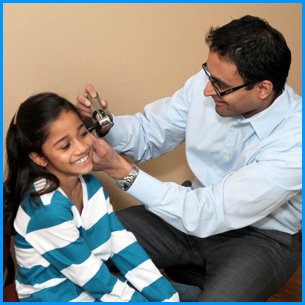Working with ears for better hearing...
Cholesteatoma Removal
A cholesteatoma (or keratoma) is a benign tumor-like growth that is in the form of a cyst of skin and may involve the middle ear, the mastoid, the external ear canal or a combination of these. Once a cholesteatoma forms, it continues to enlarge and cause further destruction and infection within the ear which can lead to more serious complications. A cholesteatoma can develop from chronic ear infections, when the passage between the ear and the nose (the eustachian tube) is not functioning correctly or may be part of a congenital condition. Children who suffer from a cholesteatoma often exhibit the following symptoms:
- Decreased hearing in the affected ear
- Persistent or recurrent foul smelling ear drainage

Diagnosis of a cholesteatoma is usually done by careful examination, often using a microscope. Initial treatment/evaluation usually involves cleaning the ear, and/or using eardrops and antibiotics to control any secondary bacterial infection. The treatment of a cholesteatoma is always surgical removal. To plan for surgery, growth characteristics of the cholesteatoma need to be determined. This is typically accomplished with a CT scan of the ear. If the cholesteatoma is confined to the middle ear or ear canal surgery may be confined to those areas only. Removal of cholesteatomas confined to the middle ear is often completed in conjunction with a tympanoplasty (repair of the eardrum where the cholesteatoma started).
Mastoidectomy
Larger cholesteatomas have often progressed to involve the tract of air cells behind the ear known as the mastoid bone. If the cholesteatoma has grown into the mastoid your child’s surgeon will have to access the bone in order to completely remove the entire cholesteatoma. The process of hollowing out the bone behind the ear with a surgical drill is known as a mastoidectomy. This is started by making a curved incision behind the ear. In general, there are two approaches to mastoid surgery: Canal-Wall-Up vs. a Canal-Wall-Down. “Canal-Wall” refers to the bone of the ear canal. Your surgeon will discuss these procedures in more detail during your visit, but in brief:
- Canal-Wall-Up – in this procedure the goal is to preserve as much of the normal anatomy of the ear as possible.
- Canal-Wall-Down – in this procedure the ear canal and mastoid cavity are combined into one space with a much larger opening into the ear canal. This procedure is commonly known as a “radical mastoidectomy.”
The primary goal of cholesteatoma removal surgery is to achieve a “safe” ear by removing all of the cholesteatoma so that there is no further destruction/infection. Restoration of hearing involving reconstruction of the ossicular chain is often completed as a second surgery. The ENT for Children team manages the long-term follow up care that is integral for the successful management of this disease.
Ossicular Chain Reconstruction

A surgical treatment called Ossicular Chain Reconstruction is used if injury has occurred to the ossicles. The ossicles are three small bones positioned behind the ear drum that constitute the Ossicular Chain, these bones connect the ear drum to the inner ear. This surgery is used to reconstruct the ossicular chain and improve hearing. The surgery to reconstruct the ossicular chain is often completed during a “second-look” procedure. This “second-look” procedure is a follow up surgery usually 6-12 months later to insure that there is no residual cholesteatoma.
Ossicular chain reconstruction may be completed by making an incision behind the ear or going through the ear canal to make the incisions. If the middle ear bones are damaged, it may be possible to reposition the bones such that your child’s own ossicles are used to complete the reconstruction. If the ossicles or parts of the ossicles are absent or damaged, then they are replaced with a manmade prosthesis that is often constructed from titanium. A prosthesis can be used to:
- Bridge a gap between damaged ossicles
- Bridge a gap from the ear drum to the residual ossicles (partial ossicular prosthesis)
- Bridge a gap from the ear drum directly to the inner ear (total ossicular prosthesis)
